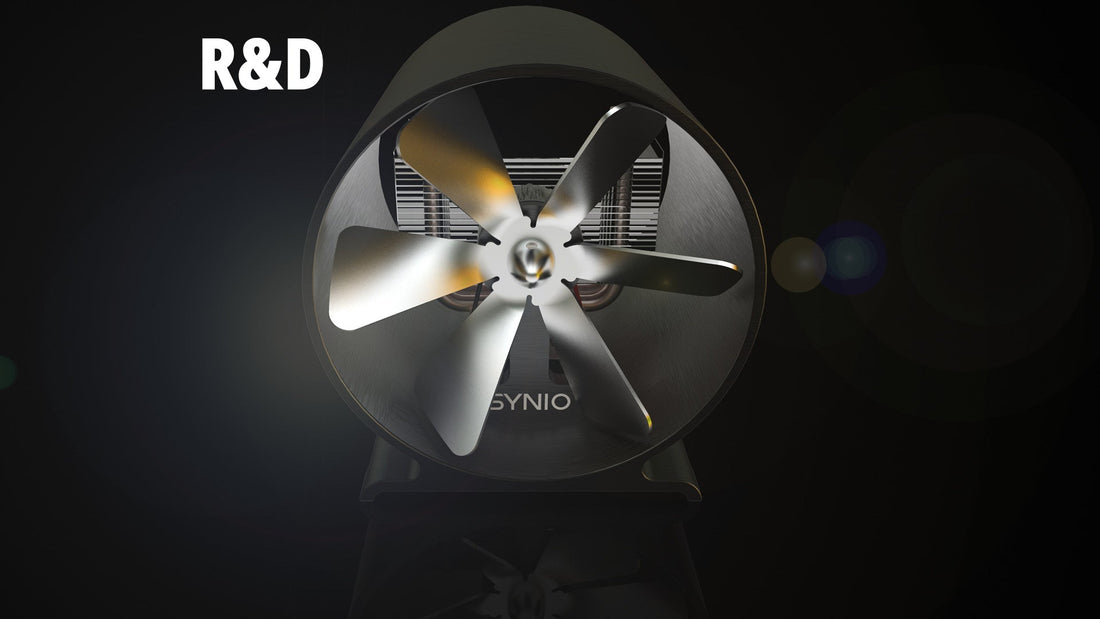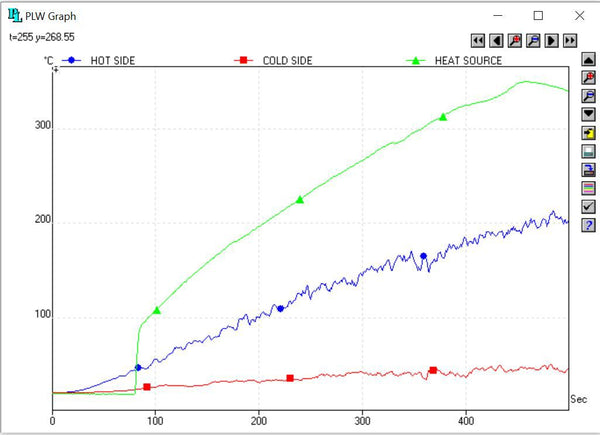
Synio Stove Jet (R&D)
Share
Overview
The project started when I installed a multi fuel log burner, I was dissatisfied with the output of heat compared with my traditional open fire. I researched how to increase the output of heat and came across stove fans. I researched the market but struggled to find a fan to fit under the gap under my fire. It's very small so I was limited to the size of fan available on the market.
The specification said the fan was 125mm but in reality it was around 130mm, the handle on the top wasn’t accounted for and the stove fan moves up when it reaches a high temperature.
I modified the Generic Stove Fan and made it smaller and this worked for a few days until the system stopped working. Knowing what I know now, this was because the motor was too hot due to high radiant heat in a confined space. I decided to embark on a project to design an improved stove fan and teamed up with engineers to collaborate on the Synio Stove Fan.

Generic Stove Fan
About
The Generic Fan is the smallest, most compact fan we have found on the market.
The intended function of the fan is to move the radiant heat into the room and make the stove more efficient and save fuel.
The primary construction of the fan is made from aluminum extrusions, this is the most cost effective method of producing aluminum bodies.
A thermoelectric module is the energy source that powers a DC motor, heat energy is transferred from the stove through the aluminum body to the thermoelectric generator (TEG).
The TEG produces energy through the seebeck effect, the opposing side needs to be cooled.
The top half of the aluminum extrusion is effectively a heatsink. The bigger the differential between hot and cold the more power is produced.

Design Limitations
The majority of stove fans use basic thermoelectric modules that have a low melting point, around 200c this means that the module can easily overheat and stop it from functioning.
To prevent the system overheating a bimetallic strip is fixed to the base of the fan, when the strip reaches a certain temperature it bends and lifts the fan to block the heat overheating the TEG.
The competition increases the size of the fans to output more airflow, the bigger the heatsink the more top heavy the structure becomes, when the fan is raised due to overheating the fans become unstable and vibrate creating annoying noises for the user.
The stove fan blades can also be easily bent out of shape and become unbalanced which creates excessive noise at high RPM.
The optimum working temperature of a fire stove is around 300° C, the current fan will lift up due to the metal strip being overheated, this throttles the energy and is inefficient.
The metal strip angles the airflow upwards, heat rises and this is also inefficient.
The heatsink is exposed to high radiant temperature and this will make it less effective.
The blade pitch is also very shallow, we believe this is the case because of the excess torque this would produce making the fan unstable at high RPM.

| 1 | Carrier Handle |
| 2 | Propeller |
| 3 | Extruded Aluminium Heatsink (Cold) |
| 4 | DC Electric Motor |
| 5 | Basic Thermoelectric Module |
| 6 | Extruded Aluminium Heatsink (Hot) |
| 7 | Overheating Metallic Metal Strip |
Synio Stove Fan

The Synio stove fan is designed to use power from a thermoelectric generator (TEG) to power a fan which distributes hot air from the stove throughout a room. The TEG is the only power source used to drive the fan.
TEGs are a semiconductor device that produce power when there is a temperature difference across the hot and cold sides of the device. The greater the temperature difference across the hot and cold sides of the TEG, the more power is produced.
The Synio Stove Fan addresses the failings of current designs on the market and we have devised an improved version with several innovative features including producing more power and increased efficiency and performance.

- We have ducted the stove fan for the following reasons
- Increases airflow (m3/hr)
- Reduces noise from the vortexes at the tip of the propeller
- Protects the propeller from accidental damage
- Safer for the user because the spinning propeller is more guarded
- The motor is protected from the harsh radiant heat of the stove
- The heat sink is protected from the radiant heat to keep it cooler
- The radiant heat is pulled off the heatsink and transferred into the room
- The airflow is channeled through the heatsink to create a differential temperature which produces more energy.
- The efficiency of the cooling system creates a feedback loop where the motor driven fan strips more heat from the cold side of the TEG, thus creating more power to drive the fan.
- The heatsink is attached to the TEG via the heating block. The heating block is spring loaded and uses the mass of the enclosure to create consistent surface to surface contact with the hot top plate of the stove.
- The heatsink is made from copper and incorporates aluminum nickel plated sheets for enhanced cooling which gives greater temperature difference across the TEG.
- The heating block is physically isolated from the main enclosure so there is more concentrated heat transfer by conduction to the hot side of the TEG. Separating the heat block from the main enclosure prevents the heat spreading to key components.
- The Synio Stove Fan uses a TEG with higher operating temperatures, which makes this product invention possible.
- The spring angles the body downwards so airflow is driven downwards to the ground.
- The physical isolation of the heat block springs reduces the vibrations from the propeller and makes operation quieter.
- The spring mounted heat block reduces the surface contact of the back feet, this slows down the heat conduction into the body.

| 1 | Extruded Aluminium Body |
| 2 | Pitched Propeller |
| 3 | DC Electric Motor |
| 4 | High Performance Heatsink (Cold) |
| 5 | High Performance Thermoelectric Module |
| 6 | Spring Loaded Aluminium Heatsink (Hot) |
Computational Fluid Dynamics (CFD)
The Synio Stove Fan underwent development utilizing Computational Fluid Dynamics (CFD). This process guided the refinement of both the heatsink and propeller, ensuring optimal design for heightened efficiency.

Comparing propeller configurations
A significant enhancement was made by altering the propeller pitch, fundamentally transforming the system. The objective is to efficiently extract energy from the stove base, channel it through the heatsink, and subsequently transfer the radiant heat into the user's room.

Working conditions simulation
The primary aim is to augment the airflow within the system, facilitated by the heated heatsink. This strategic improvement aims to amplify the overall performance of the Synio Stove Fan.

Analysis
Our test shows that the Synio Stove Fan is more efficient at moving airflow and heat when compared to the Generic Fan.
We have enhanced the design and added an extra blade to the propeller to increase airflow.
Synio Stove Fan - Offline Testing

Generic Stove Fan - Offline Testing

System Design
This graph highlights the efficiency of the system. We tested the hot and cold sides of the TEG using K Type probes and the PICO TC-08 thermal system.

Live Testing
We have done extensive testing and the stove fan is currently working most evenings. The goal is to sync the stove fan with the optimum temperatures of the stove.


Propeller Design
In our quest for optimal air movement, initial plans to use a generic propeller were thwarted by Computational Fluid Dynamics (CFD) analysis, revealing inefficiencies in its design. Undeterred, we opted for a more challenging path, designing a custom prototype fan. Laser-cutting technology and a custom bending jig were employed in the creation process, yet challenges emerged during the prototyping phase, with the achieved pitch falling short of our goals. Installing the hub presented additional hurdles, demanding creative problem-solving. However, through perseverance, we successfully crafted a bespoke fan, learning invaluable lessons along the way.



4 comments
Fantastic learning how the product is designed and developed. Thank you for your work so far and looking forward to more updates and insights.
Where can I buy these for the showroom?
In Aberdeen scotland
Looks to be a fantastically designed unit,lots of thought and testing.I will look forward to any updates,good luck.
Very interesting